Shogun Soccer Scouting #15: Yumeki Yokoyama
Striker/Winger Hybrid with Dazzling Dribbling!
A lot of my summer this year has been dominated by J1 player transfers to Europe but things continue to keep chugging along in the other levels of the Japanese football pyramid as well. So today I’ll be shifting gears to explore a very interesting J2 prospect, FC Imabari’s young attacker: Yumeki Yokoyama. Do note that he’s only played just a bit over 1100 minutes so far in 2025 (he missed the beginning of the season with a “Acromioclavicular joint dislocation” injury). I have been watching him from the 2024 J3 season though, where he completed a bit over 1500 minutes.
Let’s get started!
tl;dr (too long; didn’t read):
Fearless & agile dribbler, ignites transitions. Decision making & execution can be improved, especially shot locations & crossing.
Date of Birth: September 23, 2005
Age: 19 years old
Nationality: Japan
Position: Left Attacking Midfield/Left Winger/Striker
Club: FC Imabari (J2)
Squad Number: #36 (2024 & 2025 season)
Height/Weight: 1.72m // 67 kg (Source: SoccerDigest)
VIDEO NOTE: FC Imabari’s HOME kits are blue shirts, yellow/white highlights with white lettering, blue shorts and socks. AWAY kits are grey shirt, socks, grey shorts with blue lettering. I’m using footage from the 2025 J.League J2 season. He wears #36.
DATA NOTE: The percentile ranking stats are all from WyScout.
Space & Positioning
Yumeki Yokoyama’s main position is one of two attackers behind a main striker in a 3-4-2-1 formation. It’s fairly fluid front-line with Yokoyama making central runs behind like a striker but also pulling wide to the Left to create 1v1 situations for himself to dribble. Depending on who the other attacker is behind the striker, it quite often becomes a Front 2 of Yokoyama and Vinicius during games. He also did play more as an outright striker in a Front 2 in the 2024 J3 season. I will note that this does make data comparisons with positional peers a bit difficult as it’s not quite clear if one is supposed to compare him with strikers, wingers, or #10s. For the U-20 Japan National Team he has played as more of a traditional Winger/Wide Midfielder in a 4-4-2 or 4-2-3-1.
When passed the ball on the Left Wing he prepares well, scanning, back-stepping, and securing space for himself as he receives with an open body with his back to the left sideline. Yokoyama makes these movements with good timing as the play develops and he has a good understanding with the Left Wing Back who vacates to create this space for him in tandem. Yokoyama also creates situations to receive in good positions between-the-lines in central areas of the middle 3rd. A lot of Yokoyama’s possession involvements start from 2nd/loose balls or once the team has more slowly progressed into the middle 3rd of the pitch from the build-up phase. Yokoyama will receive the ball centrally, spread it wide, and then make his own under/overlapping runs to support the Left Wing.
Yokoyama keeps a high position between the opponent midfield and defense lines, tending to not drop deep very often. He buzzes around the striker when the team lumps the ball forward to be available for lay-offs or to scoop up the 2nd/loose balls and drive forward. This does mean that he is kept out of active involvement for extended periods of time and he doesn’t get as many touches as other attackers (on his team and in general) but that is his role on the team.
Touch & Turning
As he is receiving the ball Yokoyama is good at scanning his surroundings to know when he’s able to go forward on the half-turn. He has good agility to shift his weight, either letting the ball run across his body with or without the ball. This allows him to drive forward and take up space very quickly.
Even under pressure and receiving contact before touching the ball, he has at least shown some ability against J2 level defenders to turn forward in these situations. Still, I wouldn’t really count on him as a hold-up player by any means and that responsibility is largely on the shoulders of his Brazilian striker partner Vinicius anyway.
Dribbling & Carrying
Yumeki Yokoyama’s defining trait is his dribbling ability and technique on the ball in general. The way he dribbles and completely beat defenders 1v1 (not just create some separation) is through a combination of agility, speed, and skill. As the ball rolls to him out wide, he gauges whether the dribble is on. If it is, Yokoyama keeps an upright posture as he drives at defenders, lightly touching the ball with the outside of his Right boot and hiding his intentions.
From there Yokoyama is excellent at using body feints to unbalance defenders, his body is extremely agile to perform various stutter steps and shoulder drops that leave defenders flat-footed which Yokoyama recognizes to blast off in a different direction. Similar to when he is turning or half-turning, he has great ability to quickly shift his weight to get that bit of separation to be able to perform his next action. One of his favorite moves that you’ll find in the footage below is when he has his back to a defender and does a shoulder drop fake to misdirect. In areas with a bit more space to maneuver his speed makes him especially dangerous as he can push the ball forward just tantalizingly out of reach of the defender and accelerate away. He is in the 87th percentile for dribbling success % which is even more impressing when you also consider that he is one of the most prolific dribblers by volume as well.
All of these physical tools are enhanced by the fact that he is fairly ambipedal in his actions. This means that he can be a “double threat”, he can both go down the line to play with his Left foot or cut inside to play with his Right foot for both crossing or shooting. This breadth of choice gives defenders trouble as it’s not so simple to just show him to one side or force him on one particular foot.
Despite his issues with consistently producing good output (we’ll get to that in a later section), the abilities highlighting in this section means that Yokoyama is able to both generate his own shots or from latching on to through-balls behind. He is in the 70th percentile when it comes to touches in the box per 90, quite good considering this comparison also includes out-and-out strikers.
Aside from his 1v1 dribbling, Yokoyama’s carrying ability stands out. As mentioned prior, his ability to turn quickly allows him to drive forward with a head start, especially in transition situations. From there he makes powerful touches into space and has the acceleration to match it. From the data it’s clear the sheer amount of yards/meters he is able to progress the ball through carries, consistently hovering around 2 progressive carries per 90 which is in the upper most percentiles among attackers over the past two seasons (J3 2024 and J2 2025).
However, I do think his decision making in choosing the right path to drive forward still needs work. Smart defenders can force him down bad paths, shepherding him out wide or to other defenders to kill his momentum. Other times he can be a bit too deferential to the team’s star player, the striker Vinicius, where Yokoyama might opt to pass to the Brazilian quite early in the attacking sequence rather than carrying it further himself. This is especially disappointing when Vinicius is actually making decoy runs to open up lanes for Yokoyama to drive into.
Supporting Runs & Into Box
When it comes to the types of runs that Yokoyama makes, this is where his striker’s instincts come in. He has good acceleration to make central runs in-behind, between opponent Center Backs for lofted or through balls, curling his run across defenders from their blindside. However when it comes to the box, he doesn’t make a whole lot of runs like you’d expect from a wide attacker in terms of box crashing to either posts (these areas are usually left for the Wing Backs on the team). Instead he makes fairly central runs, in the pocket between the retreating defenders and the midfielders to the area around the penalty spot, at a slightly late timing when all the attention is on other players. In more settled attacks where FC Imabari are putting the opponent under siege, Yokoyama is more about hanging back slightly and wait for loose balls to pop up.
Shooting
A thing you’ll notice about Yumeki Yokoyama is that he takes shots, lots of shots. His 3.56 shots per 90 puts him at the 97th percentile among all J2 strikers and wingers with at least 900 minutes played. As one can imagine from a young attacker this volume comes at a price with his paltry 0.08 xG per Shot being at a lowly 19th percentile. He is very eager to get shots off with both feet from all sorts of ranges and angles. A big issue is his decision-making in these instances where he needs to be more aware of defenders in his vicinity that can easily make blocks from his shot trajectory.
On top of that he does have some issues settling bouncing balls and doesn’t quite set himself up for the shot well. He gets off-balance and leans back to snatch at shots which causes them to be blasted over or be saved at a comfortable height for the goalkeeper when a lower shot was optimal.
The one type of shot that Yokoyama does quite well is low curled shots with the inside of his Right foot. When he is able to plant his supporting foot well he is able to really wrap his foot around the ball and stroke it into the corners. He has had far more success with this technique compared to more straightforward shots driven through with his laces. There’s a few goals from the 2024 J3 season not shown here (go look on the J.League’s Youtube) that are good examples of this as well.
Overall, 5 goals is nice from a teenager but it comes from just 2.7 non-penalty xG (as per J.League official stats). Coupled with his low xG per Shot that has been consistent across both J2 and J3 seasons represents his over-performance (or a more positive spin, clinical-ness) in front of goal.
Passing & Crossing
When it comes to passing, because he is positioned up high and not intimately involved in the build-up he not only doesn’t make a whole lot of progressive passes (48th percentile) but Yokoyama has a fairly low pass volume in general (29th percentile). As seen in the previous sections he is more of a progressive pass receiver or simply an outlet.
As an attacker, Yokoyama’s passing shows a lot of creativity through a variety of scoop passes, through-balls, and crossing technique. His ability to use his Right, Left, and Outside of his Right foot makes him quite unpredictable and gives him a variety of choices. However, despite his good vision there’s still room for improvement in his actual execution as his ideas can be a bit ambitious at times. In particular I do think he struggles to get the right weight on passes when on the move compared to when stationary which ruins attacking transitions. I will note that it is a positive that he is more willing to combine and attempt to break down defenses now instead of just trying to dribble through like in the past. Yokoyama has developed good chemistry with Vinicius and the Left Wing Backs (Takatora Kondo and Kenshin Yuba).
In the final 3rd, Yokoyama is a crosser at high volumes relative to his positional peers (93rd percentile) but unfortunately his crossing accuracy is quite poor (30th percentile). On a positive note, his willingness to cross with his Left foot (along with his occasional outside Right foot) helps with being a threat when dribbling down the line on the Left Wing but he is much better when cutting in and trying to play inswingers with his Right.
Defending
As an attacker, Yokoyama is part of the 1st-Line-Of-Press in the Front 3. When pressing defenders and goalkeepers he is fairly adept at cutting passing options by approaching at an angle. He understands his team’s pressing scheme to scan his surroundings and direct the opponent’s build-up into traps or simply force them long. There’s obviously room for improvement as he can be a bit lax at times.
It still does need to be said that he doesn’t have a whole lot of defensive “activity” as he’s not very aggressive and doesn’t get “stuck in” whether in the press or in a block. Yokoyama is diligent in tracking back, does a reasonable job restricting passing lanes in deeper block situations where Imabari turn into a 5-4-1. He is alert enough to be able to spring the occasional counterattack from interceptions but the execution can be quite inconsistent. His lack of size and aerial ability limits him to being placed as rest defense on corner kicks (or support when playing it short to dribble/cross) rather than being in the box.
Summary
Yumeki Yokoyama is another in a long line of promising Japanese attacking talents. His willingness to turn and drive forward are shown in transitions and counterattacks. Despite the team’s nominal formation, he acts like a second-striker instead of just a pure touch-line hugging winger. He can receive between-the-lines in central areas, buzz around the “big man” striker teammate to collect loose/2nd balls. Still, a lot of his 1v1 dribbling is showcased when he is isolated on the Left Wing where he can threaten by both going down the line and cutting in. Despite his goals and assists in the past two seasons, his end product is inconsistent and can still improve in general whether that is his crossing, shooting, or passing.
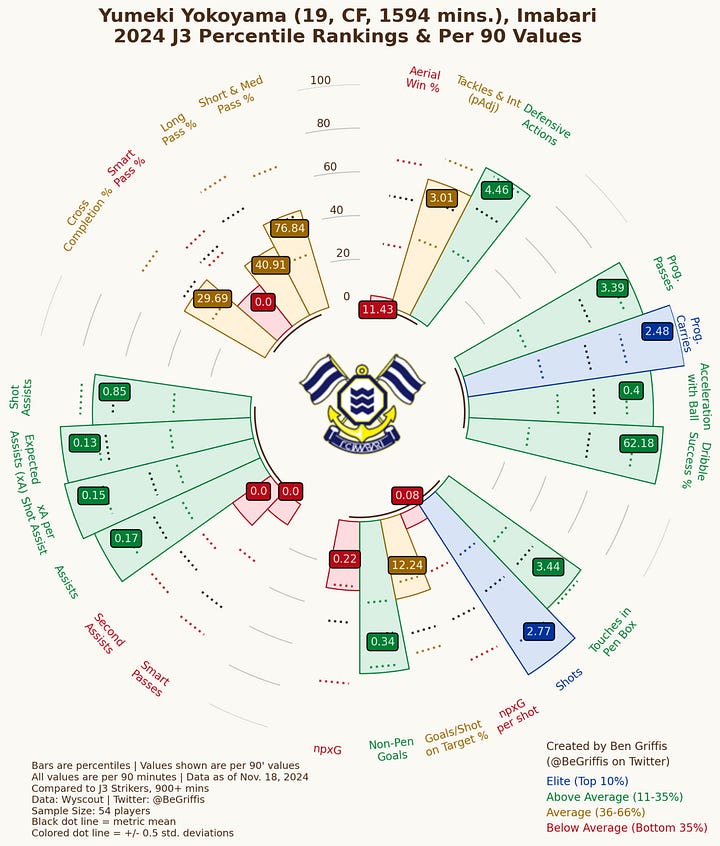
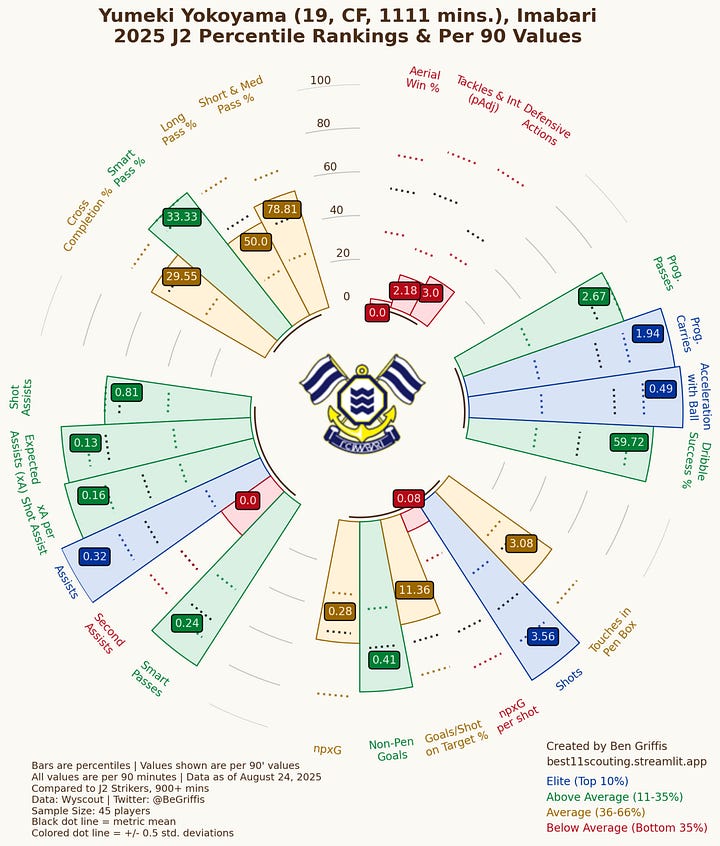
There is a recent trend to play these types of players at Wing Back (see Ryunosuke Sato, Kodai Sano in the past, Kota Tawaratsumida, etc.) but I don’t think that’s the solution for Yokoyama’s development in the near future. I am adamant that he should not be restricted to a touch-line hugging winger/wing back for the reasons mentioned in the previous sections.
I am a bit worried about his career path as I don’t want him to end up in limbo like his older brother, Ayumu Yokoyama. I think the older sibling left the J.League a bit too early (and League 1 wasn’t a great destination either) and as a result hasn’t been able to lock down a place at the first team level in Europe as a 22 year old across two different leagues. I would really like to see Yumeki Yokoyama at the J1 level next year as it’s unlikely FC Imabari will get promoted (despite them punching well above their weight so far this season). In the immediate future (from 2026 onward), as he’ll need physical adjustments as he gets into his 20s, Yokoyama’s main goal should be finding a J1 team that will develop him physically and tactically through game time.
From various interviews I’ve read, Yokoyama has been practicing conversational English online and is very motivated to play in Europe in the future. In about a year’s time (or maybe just 6 months in J1 given how the market has been these past few years) a step-up to an Eredivisie club (at the higher end of possible destinations) or a mid-table Belgium club (on the lower end) would make sense, especially ones that prefer a high octane, transition style of play. This would be to see if his skills can withstand the pressures of the physicality/agility of defenders at that level. If Yokoyama can show that he can succeed there at age 21~23 then I do think he can go to the Top 5 Leagues but the road is still very long yet.
Thanks for reading!
(Also, it’s actually my birthday today!)
Resources, Limitations, etc.
Video analysis: DaVinci Resolve 18
Tactical diagrams: Tacticalista
Time period: 2024 J3 Season & 2025 J2 Season
Footage: Broadcast footage, no tactical camera
Stats: FBref, Transfermarkt, WyScout
Player radars: Ben Griffis


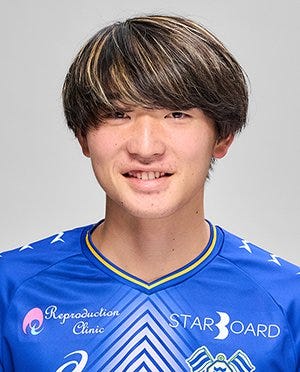
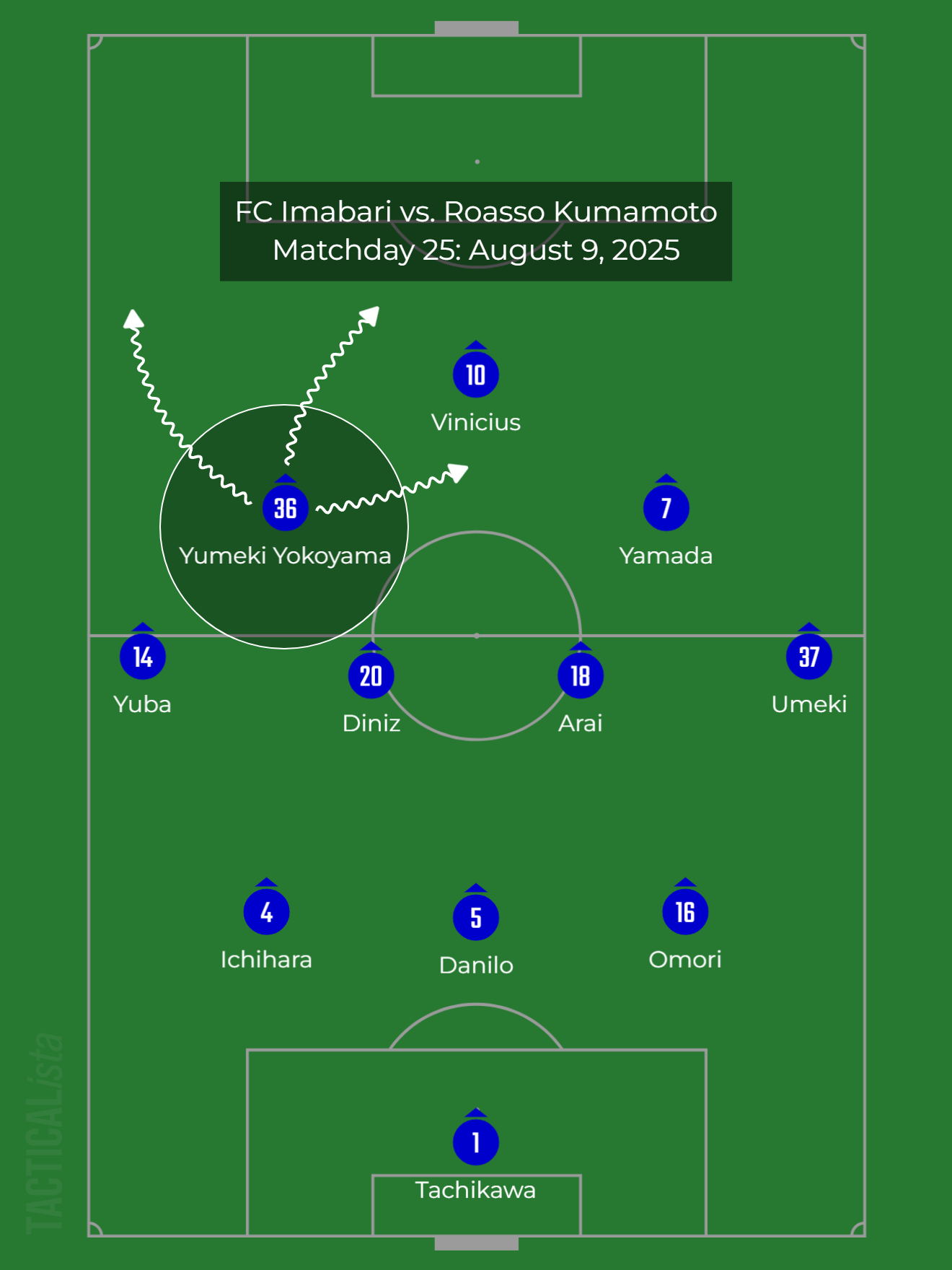
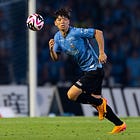
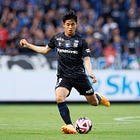
Great stuff as usual Ryo, and happy birthday mate!
Great read, Really enjoyed learning more about this J2 League starlet and hope to see more of him in the future.
Happy birthday 🥳